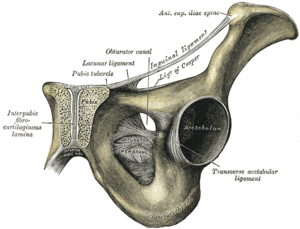Osteitis Pubis
Original Editor - Tehseen Zahra
Introduction[edit | edit source]
Osteitis pubis is a painful and chronic condition which is common in athletes affecting the pubic symphysis and parasymphyseal bone and it occurs after athletic activity.[1] It is actually an overuse condition caused by abnormal muscle forces acting on the pubic symphysis .[2] It causes pelvic pain and local tenderness over pubic symphysis. It commonly occurs in athletes who participate in sports involving kicking, twisting , pivoting,cutting and during abrupt directional changes.Osteitis pubis has been described in soccer, rugby, ice hockey,distance running players.[3]
Clinically Relevant Anatomy[edit | edit source]
Pubic symphysis is found anteriorly between adjacent pubic bounds covered in hyaline cartilage.It is stabilized by superior pubic ligament and inferior pubic ligament.[Gray's anatomy]
Mechanism of Injury[edit | edit source]
Centre of gravity of the body is located within pelvis that’s why it is greatly stressed in all athletic activities. The biomechanical forces are applied through the pelvis of an athlete during kicking, acceleration and deceleration which increases the incidence of osteitis pubis. These forces causes chronic overloading of pubic symphysis and parasymphyseal bone leading to bony stress reaction.[4]
Clinical Presentation[edit | edit source]
Athlete with osteitis pubis presents with anterior and medial groin pain or it may be located directly over pubic symphysis. Pain may also occur in the lower abdominal muscles, adductor region, perineal region, inguinal and scrotum which is aggravated by running, cutting, hip adduction,flexion against resistance and by activities that causes loading on rectus abdominis. [1]
Diagnosis[edit | edit source]
On palpation tenderness is common over symphyseal region. Several tests are performed such as pubic symphysis gap test with isometric adductor contraction and lateral compression test. Some provocation tests are helpful i.e single adductor, squeeze and bilateral adductor tests(best) for the assessment of chronic groin pain. Clinical findings can also include Positive FABER test , restricted range of hip motion, sacroiliac joint dysfunction and weakness of abductor or adductor muscles. Along with that radiographs, MRI, triple-phase scintigraphy confirms the diagnosis and exclude any other cause of groin pain.[3]
{{#ev : youtube | dzI18kubrZE}}Cite error: Closing </ref> missing for <ref> tag Most athletes return to pre-injury level within 3 months(4 to 14 weeks) while successful follow-up may take 6 to 14 months.[5]
Injection Therapy[edit | edit source]
For the treatment of osteitis pubis, Corticosteriod injections into pubic symphysis are also used as an additional approach to accelerate return to sport. Some studies have reported pain relief at short term follow-up but most are non-responder. So there is no strong evidence regarding efficacy of short and long-term use of corticosteroids.
Surgical Treatment[edit | edit source]
Surgery is performed only after conservative management fails. It may be indicated after at least 3 months of well-conduced rehabilitation program.Surgical intervention is required for 5%–10% of patients refractory to conservative approaches.[3]
References[edit | edit source]
- ↑ 1.0 1.1 Hiti CJ, Stevens KJ, Jamati MK, Garza D, Matheson GO. Athletic osteitis pubis. Sports medicine. 2011 May 1;41(5):361-76.
- ↑ Johnson R. Osteitis pubis. Current sports medicine reports. 2003 Mar 1;2(2):98-102.
- ↑ 3.0 3.1 3.2 Via AG, Frizziero A, Finotti P, Oliva F, Randelli F, Maffulli N. Management of osteitis pubis in athletes: rehabilitation and return to training–a review of the most recent literature. Open Access Journal of Sports Medicine. 2019;10:1.
- ↑ Beatty T. Osteitis pubis in athletes. Current sports medicine reports. 2012 Mar 1;11(2):96-8.
- ↑ Cheatham SW, Kolber MJ, Shimamura KK. The effectiveness of nonoperative rehabilitation programs for athletes diagnosed with osteitis pubis. Journal of sport rehabilitation. 2016 Dec 1;25(4):399-403.
.







